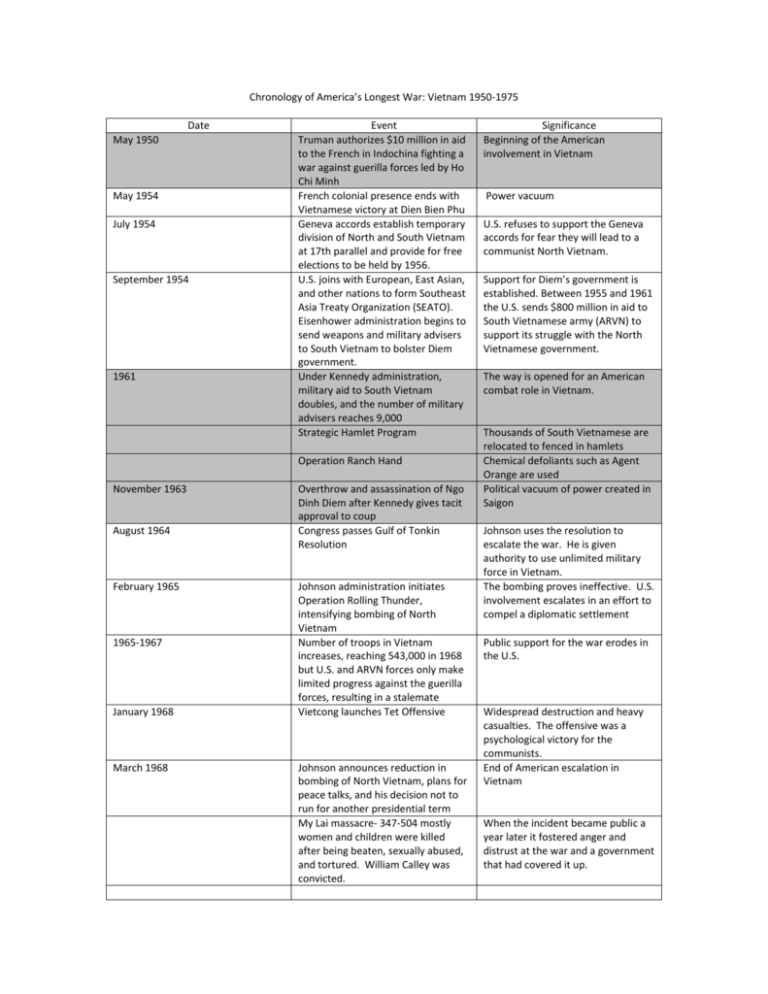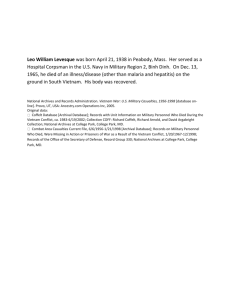Vietnam Timeline Chart
advertisement

Chronology of America’s Longest War: Vietnam 1950-1975 Date May 1950 May 1954 July 1954 September 1954 1961 Event Truman authorizes $10 million in aid to the French in Indochina fighting a war against guerilla forces led by Ho Chi Minh French colonial presence ends with Vietnamese victory at Dien Bien Phu Geneva accords establish temporary division of North and South Vietnam at 17th parallel and provide for free elections to be held by 1956. U.S. joins with European, East Asian, and other nations to form Southeast Asia Treaty Organization (SEATO). Eisenhower administration begins to send weapons and military advisers to South Vietnam to bolster Diem government. Under Kennedy administration, military aid to South Vietnam doubles, and the number of military advisers reaches 9,000 Strategic Hamlet Program Operation Ranch Hand November 1963 August 1964 February 1965 1965-1967 January 1968 March 1968 Overthrow and assassination of Ngo Dinh Diem after Kennedy gives tacit approval to coup Congress passes Gulf of Tonkin Resolution Johnson administration initiates Operation Rolling Thunder, intensifying bombing of North Vietnam Number of troops in Vietnam increases, reaching 543,000 in 1968 but U.S. and ARVN forces only make limited progress against the guerilla forces, resulting in a stalemate Vietcong launches Tet Offensive Johnson announces reduction in bombing of North Vietnam, plans for peace talks, and his decision not to run for another presidential term My Lai massacre- 347-504 mostly women and children were killed after being beaten, sexually abused, and tortured. William Calley was convicted. Significance Beginning of the American involvement in Vietnam Power vacuum U.S. refuses to support the Geneva accords for fear they will lead to a communist North Vietnam. Support for Diem’s government is established. Between 1955 and 1961 the U.S. sends $800 million in aid to South Vietnamese army (ARVN) to support its struggle with the North Vietnamese government. The way is opened for an American combat role in Vietnam. Thousands of South Vietnamese are relocated to fenced in hamlets Chemical defoliants such as Agent Orange are used Political vacuum of power created in Saigon Johnson uses the resolution to escalate the war. He is given authority to use unlimited military force in Vietnam. The bombing proves ineffective. U.S. involvement escalates in an effort to compel a diplomatic settlement Public support for the war erodes in the U.S. Widespread destruction and heavy casualties. The offensive was a psychological victory for the communists. End of American escalation in Vietnam When the incident became public a year later it fostered anger and distrust at the war and a government that had covered it up. May 1968 Paris peace talks begins 1969 Nixon administration initiates the secret bombing of Cambodia, increases the bombing of North Vietnam while reducing U.S. troops in the South, and pursues peace talks Nixon orders joint U.S.-ARVN invasion of Cambodia U.S. troops in Vietnam decreased from 334,600 to 140,000 April 1970 1970-1971 1972 1973 Jan. 1975 April 1975 With peace talks stalled, Nixon orders most devastating bombing of North Vietnam of war U.S., North Vietnam, and South Vietnam sign cease-fire in Paris. U.S. agrees to remove its troops within 60 days North Vietnam invades South Vietnam Fall of Saigon U.S. and North Vietnam quickly deadlock on peace terms Reduction of 25,000 troops from the South is the beginning of policy of Vietnamization (Nixon Doctrine) Widening of war to include all Indochina Despite withdrawal of troops, more names are listed on the Vietnam Wall Memorial from the Nixon administration that from any other president who served during the war U.S. attempts to pressure North Vietnam into agreeing to peace terms End of direct American military involvement in Vietnam U.S. unwilling to try again to rescue South Vietnam Abrupt withdrawal of U.S. from South Vietnam. Vietcong troops occupy Saigon, renaming it Ho Chi Minh City ARVN- the Army of the Republic of Vietnam was the land-based military forces of the Republic of Vietnam (South Vietnam) Ho Chi Minh- (1890-1969) founder of the Vietnamese Communist Party (1930) and first president of the Democratic Republic of Vietnam (1945-1969). Ngo Dinh Diem- (1901-1963) Prime minister and president, Republic of Vietnam, 1954-1963. Overthrown and killed in 1963. Catholic. From 1950-1954 Diem lived in Europe and the U.S. He stayed for a time at a Catholic seminary in New Jersey. General Westmoreland- general, U.S. Army commander, U.S. Military Assistance Command, Vietnam (1964-1968). Instrumental in raising the level of U.S. forces in South Vietnam and developing the military strategy of attrition for the ground war. During the 1968 Tet Offensive, Westmoreland though surprised, reacted quickly and decisively defeated the attackers. Robert McNamara- U.S. secretary of defense, 1961-1968. Dean Rusk- U.S. secretary of state, 1961-1969. Henry Kissinger- national security adviser, 1969-1975, secretary of state 1973-1977. Kissinger played a prominent role in setting U.S. policy in the Vietnam War in the Johnson, Ford, and Nixon administrations. In 1975 he received the Nobel Peace Prize jointly with Le Duc Tho. Vietminh- (League for Vietnamese Independence) formed by Ho Chi Minh in 1941. In 1946 it began a war against the French when that nation tried to reclaim control over Indochina. Vietcong- or the National Front for the Liberation of South Vietnam (NLF) was a political organization and army in South Vietnam and Cambodia that fought the United States and South Vietnamese governments during the Vietnam War (1955–1975). It had both guerrilla and regular army units, as well as a network of cadres who organized peasants in the territory it controlled.
![vietnam[1].](http://s2.studylib.net/store/data/005329784_1-42b2e9fc4f7c73463c31fd4de82c4fa3-300x300.png)





